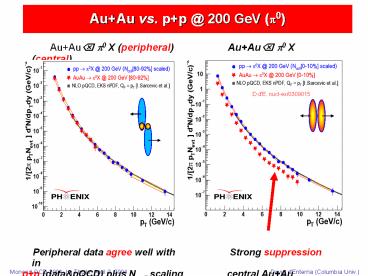Au Au vs. p p @ 200 GeV (p0) - PowerPoint PPT Presentation
Title:
Au Au vs. p p @ 200 GeV (p0)
Description:
Peripheral data agree well with Strong suppression in ... First time a large 'shadowing' is seen at small-x and high pT in nuclear syst. ... – PowerPoint PPT presentation
Number of Views:13
Avg rating:3.0/5.0
Title: Au Au vs. p p @ 200 GeV (p0)
1
AuAu vs. pp _at_ 200 GeV (p0)
- AuAu? p0 X (peripheral)
AuAu? p0 X (central) - Peripheral data agree well with
Strong suppression in - pp (datapQCD) plus Ncoll scaling
central AuAu collisions
2
Nuclear modification factor (p0)
PHENIX Collab. PRL 91, 072303 (2003)
nucl-ex/0304022
RAA ltlt 1 well below pQCD (collinear
factorization) expectations for hard
scattering cross-section
3
Nuclear modification factor (p0) ?vsNN dependence
- CERN-SPS PbPb central (vsNN 17.3 GeV) no
suppression() (within errors) - CERN-ISR aa (vsNN 31 GeV) Cronin
enhancement. - RHIC AuAu (vsNN 130, 200 GeV) x 4-5
suppression.
A.L.S.Angelis, PLB 185, 213 (1987) WA98, EPJ C
23, 225 (2002) () Reanalysis D.d'E.
nucl-ex/0403055 PHENIX, PRL 88 022301
(2002) PHENIX, PRL 91, 072303 (2003)
4
High pT azimuthal correlations jet signals in
AuAu pp
- dNpair/d?? for trigger (pT gt 4GeV/c)
associated (pT 2- 4 GeV/c) charg. hadrons
Red histogram pp (flow) Black points
AuAu Blue curve flow contribution
Periph. Central
- Near-side peak AuAu pp.
- Trigger hadrons (pT gt 4GeV/c)
- from jet fragmentation.
- Away-side peak AuAu ltlt pp
- Back-to-back jets suppressed
- ("mono-jet") in central AuAu !
5
High pT azimuthal correlations AuAu dijet
signal disappearance
- Ratio of AuAu (- flow) over pp azimuthal
correlation strengths
Near-side peak IAA 1 Away-side peak
IAA 0
6
Unquenched dAu production at high pT
- Suppression in central AuAu not due to
initial-state effects
7
dAu nuclear modification factor (? 3.2)
- Factor 2 suppression
- pT 1-3 GeV/c hadron
- production at ? 3.2
- (x2 10-4 in Au).
- First time a large shadowing is seen at small-x
and high pT in nuclear syst. - So far unexplored perturbative region of nuclear
(x,Q2) plane.
Perturbative
non-perturbative
8
Overview (Status of QGP CGC search)
- 1. Introduction
- The goal Study Quantum Chromo many-body
Dynamics QGP, CGC. - The means Compare hard scattering production in
diff. colliding had. systems. - 2. QCD vacuum reference results high pT in
pp - Baseline hard scattering data in free space.
- 3. Hot QCD medium highlights high pT in
central AA - ??dN/dpT light hadrons (u,d,s) suppressed
- ?s, pT, centrality, and meson-baryon
dependence - ??dNpair/df azimuthal anisotropies
- dissapearence of away-side dijet correlations
- ??dN/dpT colorless probes (g) unsuppressed
- 4. Cold QCD medium highlights high pT in dAu
CGC ?
9
The quest for gluon saturation effects _at_ RHIC ...
- RHIC kinematical regime
- High pT _at_ midrapidity
- y 0, Q2 1-100 GeV2/c2
- - pQCD collinear factorization
- - DGLAP evolution (g splitting)
- - small nuclear effects in PDFs
- (LT shadowing).
- Moderate pT, rapidities
- y 1-3, Q2 10 GeV2/c2
- - kT factorization
- - linear BFKL evolution (g splitt.)
- - moderate nuclear effects (LT
- shadowing).
(2 ? 2)
x small Look forward in rapidity !
10
AuAu collisions _at_ 200 GeV
600 charged particles per
unit rapidity at midrapidity (top 10 central)































